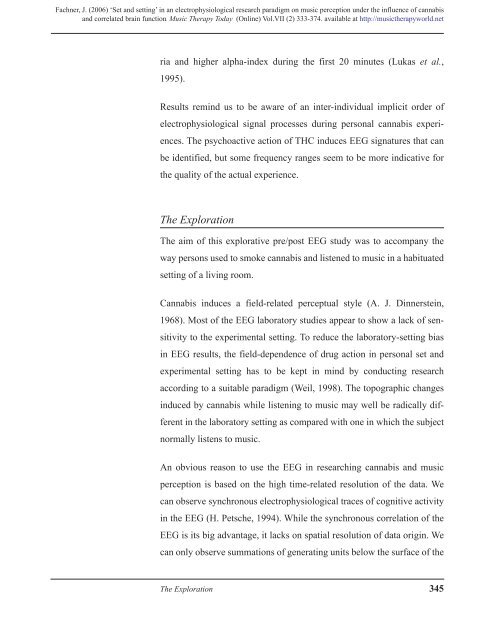Music Therapy Today - World Federation of Music Therapy
Music Therapy Today - World Federation of Music Therapy
Music Therapy Today - World Federation of Music Therapy
You also want an ePaper? Increase the reach of your titles
YUMPU automatically turns print PDFs into web optimized ePapers that Google loves.
Fachner, J. (2006) ‘Set and setting’ in an electrophysiological research paradigm on music perception under the influence <strong>of</strong> cannabis<br />
and correlated brain function. <strong>Music</strong> <strong>Therapy</strong> <strong>Today</strong> (Online) Vol.VII (2) 333-374. available at http://musictherapyworld.net<br />
ria and higher alpha-index during the first 20 minutes (Lukas et al.,<br />
1995).<br />
Results remind us to be aware <strong>of</strong> an inter-individual implicit order <strong>of</strong><br />
electrophysiological signal processes during personal cannabis experi-<br />
ences. The psychoactive action <strong>of</strong> THC induces EEG signatures that can<br />
be identified, but some frequency ranges seem to be more indicative for<br />
the quality <strong>of</strong> the actual experience.<br />
The Exploration<br />
The aim <strong>of</strong> this explorative pre/post EEG study was to accompany the<br />
way persons used to smoke cannabis and listened to music in a habituated<br />
setting <strong>of</strong> a living room.<br />
Cannabis induces a field-related perceptual style (A. J. Dinnerstein,<br />
1968). Most <strong>of</strong> the EEG laboratory studies appear to show a lack <strong>of</strong> sen-<br />
sitivity to the experimental setting. To reduce the laboratory-setting bias<br />
in EEG results, the field-dependence <strong>of</strong> drug action in personal set and<br />
experimental setting has to be kept in mind by conducting research<br />
according to a suitable paradigm (Weil, 1998). The topographic changes<br />
induced by cannabis while listening to music may well be radically dif-<br />
ferent in the laboratory setting as compared with one in which the subject<br />
normally listens to music.<br />
An obvious reason to use the EEG in researching cannabis and music<br />
perception is based on the high time-related resolution <strong>of</strong> the data. We<br />
can observe synchronous electrophysiological traces <strong>of</strong> cognitive activity<br />
in the EEG (H. Petsche, 1994). While the synchronous correlation <strong>of</strong> the<br />
EEG is its big advantage, it lacks on spatial resolution <strong>of</strong> data origin. We<br />
can only observe summations <strong>of</strong> generating units below the surface <strong>of</strong> the<br />
The Exploration 345

















